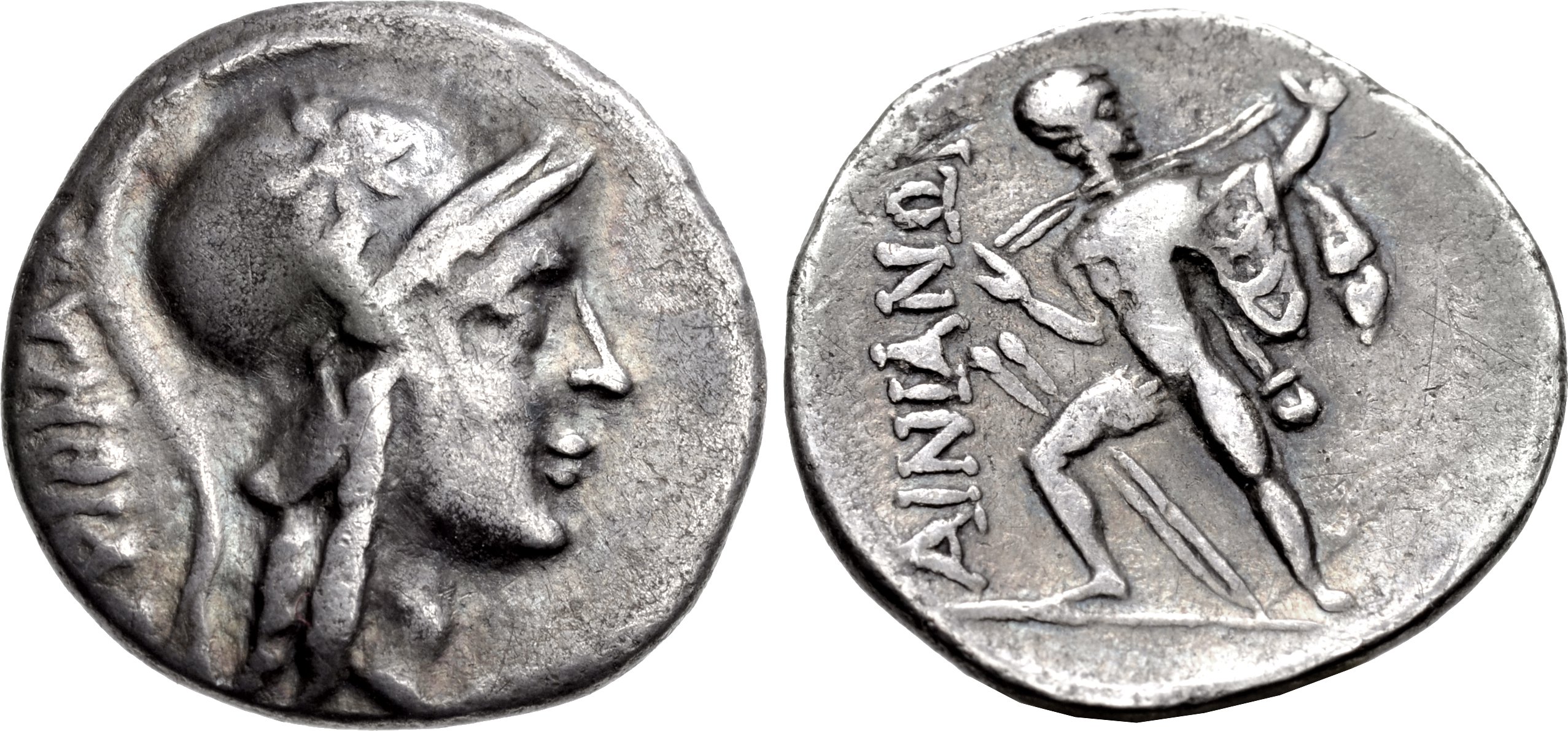S 1623 - Hypata (Ainianes), silver, tetrobols (87-84 BCE)
From SILVER
87 BCE - 84 BCE Silver 821 kg
Description
| ObverseInscription or printing placed on the obverse.: | Helmeted head of Athena right |
| ReverseInscription or printing placed on the reverse.: | (Greek).Warrior (Phemios), wearing sword, shooting sling right, two javelins behind |
Mint and issuing power
| MintIdentifies the place of manufacture or issue of a numismatic object.: | Hypata | Ancient regionAncient region.: | Thessaly | Modern countryModern country: Greece | AuthorityIdentifies the issuing power. The authority can be "pretended" when the name or the portrait of X is on the coin but he/she was not the issuing power. It can also be "uncertain" when there is no mention of X on the coin but he/she was the issuing power according to the historical sources: | Ainianes, Roman Republic |
Chronology
| FromIdentifies the initial date in a range assigned in a numismatic context. | 87 BCE | toIdentifies the final date in a range assigned in a numismatic context.. | 84 BCE | PeriodTime period of the numismatic object.: Hellenistic 323-30 BC |
Physical description
| MetalThe physical material (usually metal) from which an object is made.: | Silver |
Median weightMedian of the weights of numismatic objects (in grams). in grams | 2.30 | DenominationTerm indicating the value of a numismatic object. Examples: tetradrachm, chalkous, denarius.: | tetrobol |
StandardStandard.: |
Image

S1623 Ainianes tetrobols.jpg [1]
References
| Die study referencePublication of the study: | Callataÿ 2004a1Callataÿ 2004a, p. 134-136 | ||
| Coin series referenceReference to coin series study: | Sear I2Sear I, n° 2058, HGC 43HGC 4, n° 42 | ||
| Coin series web referenceCoin series web references: | |||
Obverse dies distribution
| FrequencyFrequency of specimen in distribution. ᵖ | Number of obversesNumber of obverse dies. ᵖ (o) | % (o) | Number of coinsNumber of coins. (n) | % (n) | Die nameName(s) of the die(s). |
| 1 | 5 | 41.67 | 5 | 18.52 | 4, 8, 10, 11, 12 |
| 2 | 3 | 25 | 6 | 22.22 | 5, 6, 7 |
| 3 | 1 | 8.33 | 3 | 11.11 | 9 |
| 4 | 2 | 16.67 | 8 | 29.63 | 2, 3 |
| 5 | 1 | 8.33 | 5 | 18.52 | 1 |
| Total | 12 of 12 | 100 | 27 of 27 | 100 |
Reverse dies distribution
no distribution is available
Quantification
| Number of obversesNumber of obverse dies. ᵖ (o) | 12 | Number of singletons (o1)The number of singleton coins. ᵖ | 5 |
| Number of reverse diesNumber of reverse dies. (r) | 25 | Number of coinsNumber of coins. (n) | 27 |
| Coins per obverse dieNumber of coins per obverse die. (n/o) | 2.25 | Coins per reverse dieNumber of coins per reverse die. (n/r) | 1.08 |
| Reverse per obverse ratioRatio of obverse dies divided by reverse dies. (r/o) | 2.08 | Percentage of singletons (o1)number of coins (n) divided by the number of singletons (o1) ᵖ | 41.67 % |
| Original number of dies (O) (Carter 1983 formula)The estimation of the number of coins according to Carter 1983 ᵖ | 17.85 | Coins struck if 20,000 as average productivity per dieCoins made if the average productivity for obverses (according to Carter) is 20,000. ᵖ | 357,000 |
| Original number of dies (O) (Esty 2011 formula)The estimation of the number of coins according to the singleton formula in Esty 2011 ᵖ (O) | 21.6 | Survival rate if 20,000 as average productivity per dieSurvival rate if average productivity is 20,000. ᵖ | 0.00008 |
| Coverage (o = % of O) (Esty 1984 formula)Esty 1984 - coverage (% of O) ᵖ (o = % of O) | 81.48% | Die productivity if survival rate 1/2,000Average productivity if survival rate is 1/2,000. ᵖ | 3,025.21 |
| Weight of silver (in kg) if 20,000 coins per die (O = Carter formula)Carter 1983 * Median weight * 20000 (*10 if gold or electrum) ᵖ | 821 kg <br /> 821 kg | Die productivity if survival rate 1/5,000Average productivity if survival rate is 1/5,000. ᵖ | 7,563.03 |
Remarks
References
- ^ Callataÿ, François de (2004), "Le monnayage d’argent émis par les Ainianes au type d’Athéna Parthénos", in Obolos, 7 (Coins in the Thessalian Region. Mints, Circulation, Iconography, History Ancient, Byzantine, Modern. Proceedings of the Third Scientific Meeting), Athens, 2004, p. 125-156.
- ^ Sear, David R. (1978), Greek coins and their values. Vol. I, Europe, London, xl, 316 p.
- ^ Hoover, Oliver D. (2014), Handbook of Greek Coinage Series 4. Northern and Central Greece : Achaia Phthiotis, Ainis, Magnesia, Malis, Oita, Perrhaibia, Thessaly, Akarnania, Aitolia, Lokris, Phokis, Boiotia, Euboia, Attica, Megaris and Corinthia, sixth to first centuries BC, Lancaster, lxxi, 563 p.